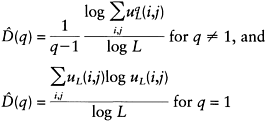122.
| [Cover] [Contents] [Index] |
Page 207
 |
(5.33) |
where uL(i, j)=[(triangular area on (i, j)th window with window size L)/(total triangular area needed to cover the image with window size L)].
Note that all these methods for estimating D(q) are based on regression techniques. Another important point which should be mentioned here is that the extension method based on Sarkar and Chaudhuri’s (1994) and Clarke’s (1986) procedures will produce an estimate with a greater bias in the case of q=0, due to the different nature of their theoretical backgrounds. However, the main aim of the comparison is to investigate image segmentation, hence the case q=0 is not of over-riding importance.
Using the multifractal dimension to quantise texture for image segmentation purposes, we may again divide an image into overlapping subimages (Figure 5.10a). Each subimage is centred on the pixel of interest. We then calculate the fractal or multifractal dimension within each subimage, and assign the value (i.e. fractal or multifractal dimension) to the central pixel of each subimage. This will generate a texture image that may be used as an additional feature in image classification. Examples of multifractal images derived from Figure 5.10b using the extension of Sarkar and Chaudhuri’s (1994) algorithm (i.e. Equation (5.32)) are shown in Figure 5.12.
5.2 Frequency domain filtering
Frequency domain filtering provides a convenient way of extracting texture information. The most widely used frequency domain filter is a simple binary mask applied to the amplitude spectrum of the image, such that information covered by the mask remains unchanged while the remainder is suppressed. Although any kind of filter shape is possible, the square, wedge and ring filters are generally used.
Several algorithms are available to transform image data from the spatial to the frequency domain. The best known of these is the Fourier transform. This algorithm generates a disc-like representation of image frequency information, with the low frequency information located around the coordinate origin (the disc centre) and the high frequency information near to the disc boundary. Analysis of the distribution of the spatial frequency representation of an image can provide measures that describe image texture.
| [Cover] [Contents] [Index] |
EAN: 2147483647
Pages: 354